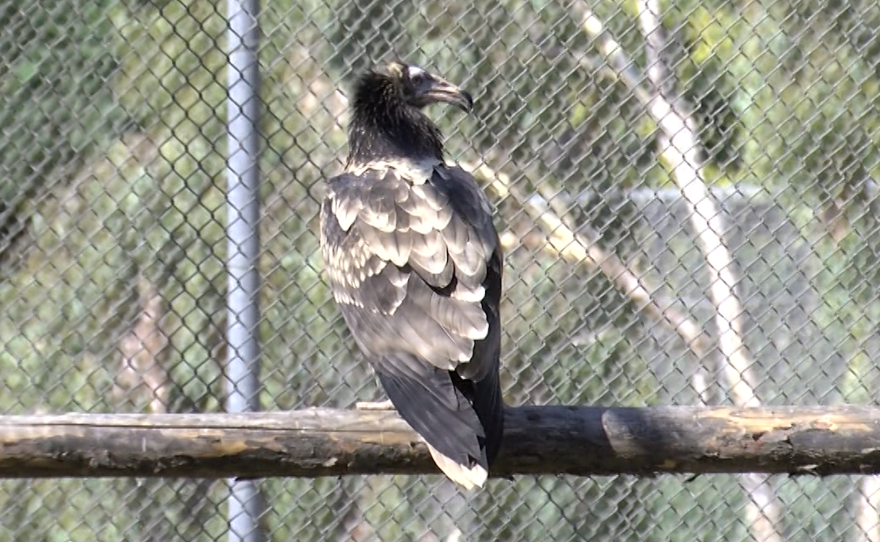The San Diego Zoo Wildlife Alliance has done something they have not done in the organization's 105 year history, hatch an endangered Egyptian Vulture.
The chick is now a few months old and lives in an isolated part of the Safari Park.
Daisy Rivas is the wildlife specialist who works in the aviary.
“Hi guys, good morning,” Rivas said as she walked up to the enclosure where the breeding pair live.
The male is quite striking, with mostly white feathers and fluffy white plumage around his head. It looks somewhat like a white lion’s mane. The 23-year-old bird is on a perch that lets him survey not only his enclosure, but nearby areas as well.
The female is also white, but with plumage that sticks closely to her head.
Both birds are wary about their human visitors.
RELATED: San Diego Moves To Protect Sea Lions At La Jolla Point
“They are such special vultures,” Rivas said. “They are the only tool using vultures so they are very smart birds. They use rocks to break open ostrich eggs and they take a lot of the different parts of the carcass that other birds can’t get to. So they just play an important part in the ecosystem.”
Rivas does not typically spend a lot of time interacting with the birds, in fact she can monitor the animals from a nearby shed. There is a cabinet with video monitors that track the birds around the clock.
“So we have the opportunity to look at the bird’s behavior without disturbing them too much,” Rivas said. “We actually have cameras on a lot of our nesting areas. So this is a great view of our nesting area for the breeding pair of Egyptian vultures.”
An elevated square box serves as a nest inside the enclosure. In the wild, the birds typically clear a flat rocky area on a ledge or in a cave to lay an egg.
There is a low barrier inside the box to keep any eggs from being pushed out of or rolled out of the nest.
The nest is screened from a pair of territorial Palm Nut vultures that are in the next enclosure. Rivas wants the bird to be aware of each other.
RELATED: UN Issues Code Red On Climate
“But it’s also good for them to not be able to see these guys when they’re sitting so they don’t get distracted but they can see them anywhere they are perching and they can make sure they’re protecting the area from other birds nearby,” Rivas said.
The mating pair has accomplished a first in North America producing and fertilizing an egg, which hatched earlier this year.
The Safari Park’s lead condor care specialist Ron Webb showed off the trailer where the endangered chick was puppet fed.

Video of the fledgling chick, which was name Jamila, show the bird taking food from puppets designed to keep the bird from imprinting on its human caretakers.
“We have one way windows in here,” Webb said. “So as long as this light is on and this lights off, she can’t see us. But we can see her.”
The feedings started with a simple sock puppet and a pair of tweezers.
“Old World vultures tend to take food directly from their parent’s beaks,” Webb said. “They’ll eat the regurgitation, but they’ll also take little bits. So we do actually pick up little pieces of food and hand it to the chick.”
RELATED: Wildlife Corridors Important For Southern California, Nation
As the bird grew the sock puppet was replaced by a more realistic one that staff use to care for condor chicks.
“When they’re young its easy,” Webb said. “When they get older they start pulling on them like they do with the parents skin in the nest pot.”
That tiny tan chick is now fully fledged.
It still has brown feathers, but those will turn white as it gets older.
Captive breeding only happens in a handful of locations in Europe and Israel and those efforts produce a small number of birds each year.
The birds in San Diego are the only breeding pair in North America and they mark the beginning of a captive breeding effort in this part of the world.
The vulture’s arrival in San Diego is being cheered by international conservation groups.
“Yes,” said Steffen Oppel, a conservation scientist for the Royal Society for the Protection of Birds. “It is very welcome to have a broader network of zoos that have that species and can potentially provide birds for release programs.”
RELATED: Climate Change Raises Risk For Outdoor Workers
More than half of the vulture’s population has been lost to hunting, poison and electrocution in the last 40 years. The population continues falling in parts of Europe and Africa, but there are conservation successes.
“In southern France and in northern Spain and on the Canary Islands,” Oppel said. “Intensive conservation programs have actually managed to reverse the fortune of the Egyptian Vulture but they are working very closely with communities by changing the way we build electricity infrastructure.”
But the threats to the migrating vulture loom large and the wild population remains under pressure.
That makes captive breeding efforts at places like the San Diego Zoo so critical.
Efforts here will help bolster the captive population in North America and could help uncover keys to the animal’s survival in the wild.






